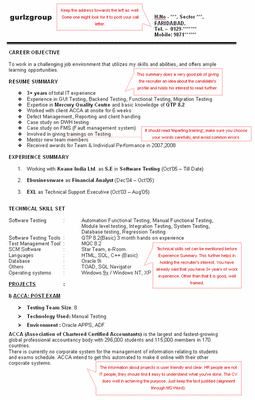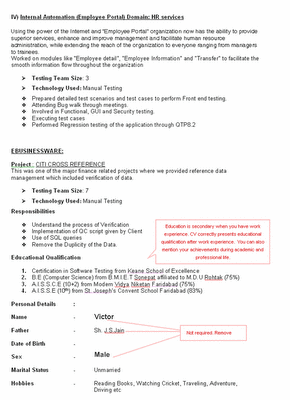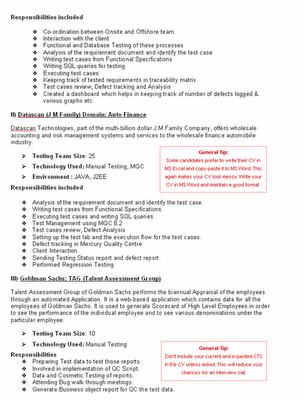Effective Resume Writing | Best Professional Resume Format | Resume Examples | Best Resume Examples
Resume writing can seem like an intimidating task, but it’s actually easier than you think. Your resume only has one job to do: It must pique the interest of your potential employer. That’s it. It doesn’t have to tell your life story and it doesn’t have to answer every question a potential employer might have.



Here is how to write an effective Business Resume
Difficulty: N/A
Time Required: 60 minutes
Here's How:
1. Start by researching the companies that interest you. Next, read publications or websites directly related to your target industry. Are there particular requirements that are frequently mentioned? If so, use these requirements as keywords throughout your resume.
2. Detail your previous experience. Think about your background and past experiences. Take what you learned in business school and apply it to the job you seek. Emphasize relevant skills and related accomplishments.
3. If you have degrees, certifications, or specialized training, note it. Try to include any related unpaid work that you have done, such as internships.
Whatever you do, don't list your hobbies unless they directly apply. Concentrate only on what demonstrates your value; leave everything else out.
4. As you are writing, try not to use the same words over and over. Avoiding repetition will make your resume more exciting. Drop in some of the following action words to jazz things up a bit:
* Accomplished
* Achieved
* Attained
* Completed
* Created
* Delivered
* Demonstrated
* Enhanced
* Expanded
* Improved
* Increased
* Managed
* Obtained
* Performed
* Produced
* Secured
* Succeeded
* Surpassed
5. Next, make sure everything is neatly typed and spelled correctly. Your resume should be eye-catching without being flashy. Above all, it should be easy to read.
If you need ideas for layout and structure, find resume samples online or go to the library and study a book. Both outlets will offer many examples of professionally written resumes. (A great online place is: jobsearch.about.com)
6. When your resume is finished, read it over carefully and make sure that it properly demonstrates your value as an employee. If so, you have written an effective invitation to employers. All you need to do now is sit back and wait for the phone to ring.
Do's and Dont's
Things you SHOULD do with your resume
- Use 8-1/2”x11” paper.
- Make your resume as legible as possible and only include necessary personal information
- Include both a permanent contact and present address and phone number. You may be contacted through a permanent number, long after you have moved
- Include your job discipline(s) near your name at the top of page one of your resume and on each assignment
- Include a summary paragraph near the top of your resume. Be brief, complete and include buzzwords. Omission of just one buzzword can prevent retrieval of your resume in a search
- List jobs in reverse chronological order
- Be consistent in calling out similar information (i.e., Jan. 98 or January 1998 or 1/98)
- List “under contract to” for any contract assignments you may have worked
- Give security status, if any. If your security clearance has expired, include the date of expiration
- Write job descriptions in easy-to-understand terms, and as completely as space allows
- Include your name and page number on each page of a multiple-page resume (do not number first page)
- If you have a length problem due to extensive number of job assignments, leave the oldest positions off and type “Experience from (date) to (date) available upon request.” Then prepare a “complete” resume to furnish only to firms asking for it.
- If you want to use a better quality paper, consider a white bond paper with a rag content (available from most printers or paper supply stores). Rag bond, however, should not be used if you are printing copies on a photocopier or laser printer, since any machine that uses toner and heat has a tendency to “flake” along creases of that kind of paper.
Things you SHOULD NOT do with your resume
- Don’t include personal references or hobbies
- Don’t include your Social Security number
- Don’t include a cover sheet (unless you have important information that cannot be included on your resume)
- Don’t use a “Job Objective.” This is normally on a resume for someone seeking a “captive” position. A “Job Objective” tells the firms what you want from them, a “Summary” tells what you can do.
- Don’t exaggerate your experience
- Don’t show salary or pay information
- Don’t offer explanations for leaving prior employers
- Don’t use your photograph
- Don’t use uncommon abbreviations (acceptable acronyms in the engineering/technical fields, such as IBM, CAD, UGII, HTML, VB, RDB, etc. are fine)
Seven Tips for Effective Resume Writing
- Pay attention to detail. Don't cut corners by, for instance, not proofreading the cover letter, failing to include information the hiring manager asked for, or beginning the cover letter "Dear Sir or Madam" when the hiring manager's name is on the company web site. Take the time to make sure the correspondence and information sent is correct and error-free.
- Do the basics. Proofread for spelling, grammar, and tone, and make sure you have followed the instructions of the employer. Firing off an e-mail is a convenient method of communication. However, don't let the sloppy nature and informality of e-mail correspondence seep into your communications—whether it's e-mailed or written—with potential employers.
- Construct an effective resume. Organize your information in a logical fashion and keep descriptions clear and to the point. Include as much work experience as possible, even if it obviously doesn't relate to the job you are seeking. Also, use a simple, easy-to-read font.
- Customize their response. Address the hiring manager directly, and include the name of the company and the position for which it is hiring in your cover letter/e-mail response.
- Make it easy for the hiring manager. Use your name and the word "resume" in your e-mail header so it's easy to identify. If the employer asks for information—such as references or writing samples—provide it.
- Focus on what you bring to the employer, not what you want from the job. This is an opportunity for you to market yourself and stand out from the other candidates. What can you do to make the hiring manager's life easier? What can you do to help the company?
- Be professional. You won't be taken seriously if you don't have e-mail or voice mail/answering machine. If you don't have e-mail, set up a free account through Yahoo! and Hotmail. Provide the recruiter with a cell phone number if your voice mail/answering machine doesn't pick up when you are online. Also, it's a good idea to ditch the cute e-mail address or voice mail/answering machine messages in favor of something that sounds professional.
No comments:
Post a Comment